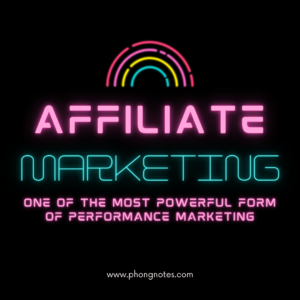This writing is a part of digital marketing notes that I summarize myself during my own work as digital transformation. During that journey, I find out that lots of SMEs manager/ founder lack foundation of online marketing. Therefore, this series emerges. It offers non-specialist an overview but details enough for performance management/ ROI.
You can check the initial note about the performance marketing definition here.
1. Definition
Firstly, according to Investopedia, affiliate marketing is an established form of performance marketing. It is an advertising model in which a company compensates third-party publishers a benefit (financial or others) to generate traffic or leads to its target page/ landing page. The third party is called affiliates, while the commission fee incentivizes publishers to find ways to promote the company.
Among companies that deploy affiliate marketing, Amazon is among the most famous pioneer whereby websites and bloggers quote its product link through their channels to receive advertising fees when a purchase is made. Thanks to Amazon’s pioneer, now affiliate marketing is essentially a pay-for-sales performance marketing where the act of selling is outsourced across a vast network.
2. Type of affiliate marketing
Next, An affiliate marketer works as a salesman. They are going to convince their audience of one product/service that they might get experience. It means that they might not use it but simply promote it for incentives. The simple reason is that they might possess some advantages such as the audience demographic group that brands desire to reach.

The paying model varies based on product features or customers’ consumption behaviours. It means that along with buying behaviour or product development changes, paying models can be changed.
People categorize affiliate marketing by some main features, including:
- The relevance of brands
- Payer side
In this note, I would like to focus on the most popular classification. Though out there, you guys might find different ways which are normal. Any marketer to segment themselves. I hope these choices simplify your understanding.
2.1. The relevance of brands
The renowned affiliate market Pat Flynn (2009) categorized affiliate marketing into 3 types: unattached, related and involved based on their close tie level to one product/service.
Unattached
the marketer has no connection to the product they are promoting. Typically, an unattached affiliate will run PPC (pay per click) marketing campaigns, using an affiliate link in the hope shoppers will click it and make a purchase on their own.
Related
It is the medium between unattached and involved which is for those who don’t necessarily use a product/service but somehow are related to a target audience of a brand. This kind of affiliate often has some sort of influence on the niche followers and can therefore offer some authority.
Due to their limited product experience, their credit is low. In many cases, the product they promote is bad which eventually disrupts their reputation.
Involved
It is the group of an affiliate that brands prefer to work with most and in long term. As the name suggests, involved affiliates describe those who are closely tied to the product/service they are promoting. They have tried the product and offer their own experience, therefore they have the authority to claim about its use. Rather than relying on CPC, their personal experience is more reliable and convincing to audience the better. Customers can trust their shares. Their effort requires more legwork therefore pays off down the road.
2.2. Payer side
Regarding payment models, we have:
Cost per action (CPA)
It is the most basic payout model as publishers earn a commission for a specific action. The reason for its popularity is its flexibility. The action is specified by the affiliate network, with an exact description of how to earn an incentive. You will know exactly how to process. Actions can vary case by case. They are: product/service review, fill in form to get coupons,…
Cost per Sales (CPS)
is a model in which you earn a commission for every sale you make. This payout is familiar with ecommerce offers where the ultimate goal is to convince a user to purchase a product.
Cos per install (CPI)
only emerges during the mobile era in a few decades. Basically, you will earn a commission for each time a user installs an app on their mobile device. Some deals can be tougher as marketer is required to trigger users to finish a transaction or activate account, which refers to CPA above mentioned.
This model is especially for mobile applications and game publisher.
Cost per Lead (CPL)
earns you a commission every time a user signs up. This is a way to generate a lead, widespread vouchers, and samples. In this format, user has to leave their contact details such as phone or email address or home address to get a free gift/ give-away.
Besides, I also collect a bunch of companies that are well known for affiliate marketing services that making-money-online communities prefer. They are:
- Amazon Associates
- Shopify Affiliate Program.
- Affiliate Future
- AvantLink
- CJ Affiliate (formerly Commission Junction)
- ClickBank
- FlexOffers
- LinkConnector
- ShareASale
As Google & Facebook offer clicks with real time bidding prices, CPC – cost per click and CPM cost per mile are the rarest models used.
3. In a nutshell
Lastly, like I said as demand and consumer’s behaviour changes, the “action” and “requirement” can be changed accordingly. The change might happen via different channels such as email instead of leaflet, regardless payment model.
According to Statista, business spend 2022 on affiliate marketing will hit $8.2 billion in the U.S market. According to a recent report from Business Insider: report on the state of affiliate marketing: Affiliate marketing is growing and accounts for approximately 15% of the digital media industry’s revenue. Affiliate marketing now drives as many e-commerce orders in the U.S. as email. Publishers often take a native approach to affiliate marketing by embedding product links within organic content.
Norwich, June 2022.
Hand copied and re-mixed by Hai Phong